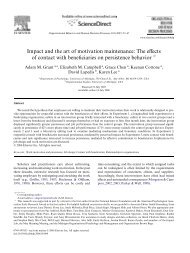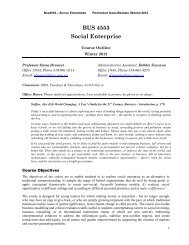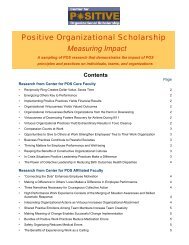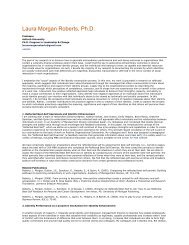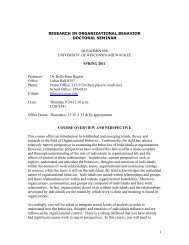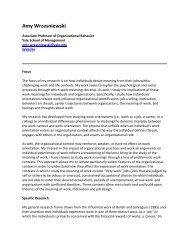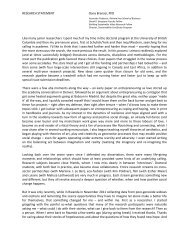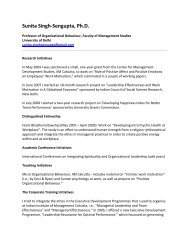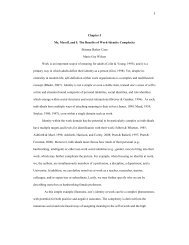Pos ID Conf-Orgs and.. - Center for Positive Organizational ...
Pos ID Conf-Orgs and.. - Center for Positive Organizational ...
Pos ID Conf-Orgs and.. - Center for Positive Organizational ...
You also want an ePaper? Increase the reach of your titles
YUMPU automatically turns print PDFs into web optimized ePapers that Google loves.
Exploring <strong>Pos</strong>itive Identities <strong>and</strong> Organizations <strong>Conf</strong>erence – January 24-26, 2008<br />
<strong>Pos</strong>itive Identities <strong>and</strong> Organizations <strong>and</strong> Communities - Scribe’s Notes<br />
Scribe: Vera Sacharin<br />
Group members: Mary Ann Glynn, Matt Kraatz, Mike Pratt, Denny Gioia, Spencer<br />
Harrison, Kevin Corley, Ian Walsh, Shelley Brickson, Grace Lemmon,<br />
Maria Farkas, Aimee Hamilton, Jane Dutton, <strong>and</strong> Jerry Davis.<br />
Note: The order of comments was adjusted by topic <strong>and</strong> is not necessarily a chronological<br />
representation of the discussion.<br />
Suggestion: There are (a few) cross references. You might want to search the document <strong>for</strong> your<br />
name in addition to reading your own chapter part.<br />
1
MIKE & MATT’S CHAPTER TIME<br />
Summary of chapter <strong>and</strong> question to group:<br />
Mike: Social truth: Organizations are different things in multiple environments, with<br />
different institutions, <strong>and</strong> individuals that have different roles.<br />
Second, organizations are something whole.<br />
Relation to James: I <strong>and</strong> me. Multiple identities but one self (the knower)<br />
Premise: Organizations are pluralistic with multiple identities <strong>and</strong> multiple<br />
responsibilities good <strong>for</strong> creativity, but bad <strong>for</strong> legitimacy, hypocritical, conflict.<br />
How do you tap into plurality <strong>and</strong> get the positive out of it?<br />
Reference to Social Identity Theory, Institutional Theory,<br />
The self of an organization: Socially constructed <strong>and</strong> different from a simple aggregate of<br />
multiple identities.<br />
What are good ways to create a self? Self here is metaphoric.<br />
Help from group: Does idea make sense? Other literatures?<br />
Kevin: Why this metaphor of ‘self’ <strong>and</strong> not some other metaphor, like ‘machine’ What about<br />
‘self’ is so useful?<br />
Mike: Lots of ways to integrate people. What is good about self: Unity <strong>and</strong> multiplicity.<br />
Other models are more about either unity or multiplicity. ‘Machine’ not organic.<br />
Spencer: ‘brain’<br />
‘Ecological’<br />
Matt: Identity is good because there is many ways to talk about it. ‘self’ is both multiple<br />
identities due to roles, but united somehow ‘housed’ or ‘imposed upon the same entity’.<br />
Shelley: ‘self’ more to do with the soul, fundamental essence of what something is<br />
(instead of just cognitive) <strong>and</strong> relates to relationship partners.<br />
Ian: Ideographic identities, holographic identities. ‘self’ seems to be both.<br />
Mike: Ideographic <strong>and</strong> holographic - holographic: mere aggregate. But missing is the<br />
next step. But ‘self’ different than aggregate.<br />
Shelley: We don’t want to work with people/organizations that are hypocrites. We need<br />
to see organizations as actors, anthropomorphize. One of the aspects of ‘self’ that you<br />
need to see organization as human being. Entity as to be capable of purposeful action.<br />
Matt: there has to be a ‘we’ = ‘I’ there<br />
Shelley: It cannot just be the product of the environment; it has to have purposeful action.<br />
2
Matt: It has to have a subject <strong>and</strong> react to the environment at the same time.<br />
Mary: What is different between individual <strong>and</strong> organizational self?<br />
Mike: An individual has a private sense of self, but organization, it‘s hard to image that<br />
<strong>for</strong> an organization. An organization is a public entity.<br />
Aimee: ‘Self’ on the individual level can be dysfunctional, but still survive. How about<br />
organization? Survival is continuous on one identity.<br />
Shelley: Organization has internal stake-holders, not <strong>for</strong> individual.<br />
Jane: Can you give a concrete example?<br />
Mike: Most of work is done in hospitals with different units, professionals, departments<br />
within one health care system. Even if there is nothing that unites them, we think about<br />
them that way. Managing multiple identities, the biggest thing consultants want to do is<br />
integration. We tend to see things as wholes whether they are wholes or not.<br />
Jane: To be more concrete with an example, something organizational, is better.<br />
Jerry: How abut using a university? Michigan, we’re a sports place, free downloads<br />
place, etc. University presidents have to manage that, talking differently to donors than<br />
students.<br />
Ian: Any one of those things is incomplete, but seeing it as a whole makes the<br />
University.<br />
Matt: Not everybody is there <strong>for</strong> the same reason. In the case of a university, there is<br />
intense identification from very different people <strong>for</strong> different reasons. What is that<br />
university? Football team, arm of catholic church, research institution, etc. very different<br />
things. What is there that is coherent there? One way to look at it is ‘nothing’ – it’s an<br />
illusion. <strong>Pos</strong>t-modern perspective on the self. Just a bunch of roles. But people still think<br />
that something is there. CEOs, presidents, is called to talk about it as if there is something<br />
coherent. What is it? What about the United States? That’s talk of political leader, to call<br />
that ‘self’ into existence. An idea of robust entity is different in sociological sense. How<br />
does it get created? Partially through symbolism, partly structural, partly giving<br />
individuals part of the institution, separating it. Some neutral structures that bind the<br />
thing together. March: Adhering to process or neutral structures when nobody agrees on<br />
anything holds things together. Notion of self is not something we created. Mead in Mind<br />
<strong>and</strong> Society talks about capacity to be multiple things.<br />
Jerry: With ‘self’ advantage of multiples identities, without things falls apart.<br />
Compare UofM with University of London that does not have a ‘self’<br />
Matt: London the neutral structures are not even there then.<br />
3
Jerry: UofM with ‘self’, but Phoenix not<br />
Dennis: What is the question you want us to help with?<br />
Matt: Don’t know. Develop idea. <strong>Organizational</strong> ‘self’ as different from ‘identity’, how is it<br />
created <strong>and</strong> maintained? What are the characteristics of ‘self’ that are more or less generative?<br />
University good example. Organized anarchy described by March. What is the benefit?<br />
Maria: For whom is the organizational ‘self’ important? You could argue that <strong>for</strong> many it is<br />
not important. Some people just care about UofM being a football school, <strong>and</strong> nothing else.<br />
Same <strong>for</strong> individual identities. For whom is it important to see the all about the person? One<br />
level where it is important is at the top of the organization <strong>for</strong> the person who represents the<br />
organization. For whom else is it necessary to operate?<br />
Mike: Devil’s advocate answer, it is important <strong>for</strong> all, even if you don’t care equally, we<br />
still do. We see things as wholes. It helps individuals relate.<br />
Maria: there are situation, where I don’t care about other identities of others <strong>and</strong> the<br />
relation between multiple roles.<br />
Mike: But you care that there is some entity.<br />
Maria: self more important <strong>for</strong> person rather than others.<br />
Matt: Other paper on organizational integrity. Lots of evidence that people <strong>and</strong> organizations<br />
are judged as if there were coherent. Integrity is part of self. Coherence is opposite to<br />
fragmented, but self incorporates both. Loose coupling idea. What is holding the organization<br />
together?<br />
Aimee: How about social movements literature. What creates the self there? Matt, what do you<br />
mean by integrity? Over time? Against ethical st<strong>and</strong>ard.<br />
Matt & Mike: Coherence, like structural integrity<br />
------------------------------------------------------------------------------------------------------------<br />
4
KEVIN AND SPENCER’S CHAPTER TIME<br />
Summary of chapter <strong>and</strong> question to group:<br />
Kevin: This chapter is part of larger ef<strong>for</strong>t. We are inside an organization <strong>and</strong> we are<br />
impressed by their positivity. Look at organization identity change. Sometimes<br />
organization must change to remain what they’ve always been. And we don’t want to<br />
change. Change has negative connotations in organizations. How can we change<br />
minimally so that we don’t feel like we are something new? What we find in this<br />
organization is that they know who they are <strong>and</strong> like that <strong>and</strong> have strong confidence that<br />
who they are is the right sense of identity, but they are in an environment where things<br />
are changing, <strong>and</strong> they have to change, too. Change as something that takes energy out of<br />
individuals <strong>and</strong> organizations. How can change be a process that energizes individuals<br />
<strong>and</strong> organizations? Pulling a positive future consideration instead of ‘we got through that<br />
tough time [change time].’<br />
Spencer: I like rock climbing. Kevin is a pessimist. But after one day, he thought it was<br />
so cool. In these offices, they have their bike above the desk, a dog under the desk. They<br />
do mountain climbing, marathon. Everybody does something really cool outside of<br />
company <strong>and</strong> brings it in. They drive up to a canyon <strong>and</strong> ski down be<strong>for</strong>e going to work<br />
together. The climbing ethos infuses what they do there. The CEO misses fingers due to<br />
frost bights. So, they see costs of activity. But it brings soul <strong>and</strong> humanity to what they<br />
do. A lot of energy. One other story: In the annual strategy session. One executive talks<br />
about marketing strategy. Another walks of, takes his shirt of <strong>and</strong> starts climbing. Other<br />
executive keeps talking. When they talk about identity change <strong>and</strong> growth, it’s not with a<br />
sense of threat, but who we are enables us to change into other things as well.<br />
We would lie to get reactions to what we said <strong>and</strong> wrote.<br />
Grace: In this organization founding fathers <strong>and</strong> their activity gives them opportunity to<br />
connect with organization.<br />
Kevin: Founding fathers are still there <strong>and</strong> most adamant to reconnect. We don’t think<br />
they lost their connection, but they have sense that they have lost some connection. They<br />
are their own customers using their products. Down at the crack. And think “What do I<br />
need <strong>for</strong> this problem?”, then go back to work <strong>and</strong> figure it out. It is both about business<br />
<strong>and</strong> sport that they love. A tension is that, as they grow, they have to hire more people<br />
who are not climbers <strong>and</strong> skiers, but experts in certain things. Concern: We hire more<br />
people who don’t underst<strong>and</strong> the products.<br />
Mike: It sounds like they ask “What does it mean to be who we are?” instead of asking<br />
“Who are we?” as question within organization<br />
Kevin: That is the identity nugget. They have a strong sense of who they are. Very<br />
different from a place where people have identity ambiguity. They know who they are.<br />
But problem now is: How do we take this sense of who we are <strong>and</strong> apply it to the<br />
problem line. Now they need executives who have seen death on the rock wonder about<br />
5
how to hire an HR person. What does it mean <strong>for</strong> us to have an HR person? It’s a 300<br />
employee company <strong>and</strong> growing.<br />
Mike: Same issues as Iggy’s Press.<br />
Jane: A mechanism was bouncing of tensions as described above. What is the theory you can<br />
build from that? I don’t’ think you take that energy stuff serious enough. Look at Rendall<br />
Collins’ work on energy. The energy part is real.<br />
Jane: Energy is created in relations. Collins “Interaction Rituals” book. Collins is<br />
sociologist.<br />
Ian: Is it their identity that enables them to change their identity? Are enablers core identity<br />
elements? Are they changing themselves?<br />
Kevin: Authenticity as a process. Not about image. Are they being authentic internally?<br />
And being reflexive is important. The mechanism driving this is partially a desire to<br />
be reflexive. What does this mean <strong>for</strong> us, <strong>for</strong> our business? Route of wanting to be the<br />
best.<br />
Spencer: As much as individuals strongly identify with the place, we want to make the best<br />
karabiner because I will use it. In the conference room there is a glass table <strong>and</strong> below a steel<br />
frame with broken equipment, mobiles with broken camping devices. A ‘We show how it fails’<br />
quality control is right in the R&D lab. It is symbolic humility <strong>and</strong> a desire to be the best. Here it<br />
is elitist identity <strong>and</strong> awareness of broken stuff.<br />
Jane: How does this map unto mindfulness? Routines of inquiry <strong>and</strong> symbolic representations<br />
of danger/harm.<br />
Aimee: Your overarching concept is identity change. But really it is organizational stability in<br />
the context of change <strong>and</strong> growth. Why did you see it as identity change?<br />
Kevin: Because they are asking fundamental questions about who they are. I don’t think<br />
their labels will change, but they are coming to a realization that the meanings of the<br />
labels change. And they are open enough to the change of meaning <strong>and</strong> ask those<br />
questions, but also do not do too much talk <strong>and</strong> not enough doing.<br />
Denny: There is a connection between the two papers. Go one level higher. Kevin <strong>and</strong><br />
Spencer: How to maintain authenticity with change? Through a higher order underst<strong>and</strong>ing of<br />
themselves. Mike & Matt’s problem is coherence <strong>and</strong> the way to keep coherence is to have<br />
higher order way or label or vision of who you are to sustain multiple identities.<br />
Matt: The idea of a higher order in a world that is hierarchically structured. Rather than<br />
higher order better to think of ‘central’<br />
6
Denny: Critical issue is to sustain multiple interpretations.<br />
Jane: Central <strong>and</strong> higher order is both structural. Is there something more processural<br />
rather than structural?<br />
Denny: It is not structural, but abstraction, more abstract more ambiguous <strong>and</strong> open to<br />
different interpretations, <strong>and</strong> different people can be part of this.<br />
Spencer: Often vision pulls you <strong>for</strong>ward. Here, it is ‘Who are we?’ <strong>and</strong> that propels people<br />
<strong>for</strong>ward rather than vision. Generative aspect of who we are does not create threat to<br />
employees.<br />
Jane: Are there routines? Where is the agency in the story? Map inquiries onto routines<br />
possible?<br />
Love term ‘life <strong>for</strong>ce’ ‘holism’ something alive<br />
Maria: Suggest resource. “Culture <strong>and</strong> organization learning.”<br />
Kevin. Yes.<br />
Jane: You are not using artifacts in written story, but in oral descriptions.<br />
Kevin: Artifacts are easy, processes harder.<br />
Can we explain authenticity as a process instead of outcome or goal?<br />
Denny: Great hook!<br />
Kevin: In the place they don’t talk about authenticity.<br />
Mary: Sense <strong>for</strong> authenticity <strong>and</strong> coherence both seem to be processes of trust. You<br />
trust the company throughout changes, <strong>and</strong> with Mike <strong>and</strong> Matt it is trust <strong>for</strong> the<br />
University, trust in the institution.<br />
Kevin: Do you know ‘living the br<strong>and</strong>?’ How about the notion of ‘living the identity’ – many<br />
organizations have an identity but not strong enough to live it. Here they do. Employees still<br />
live the identity of company. Because of equipment <strong>and</strong> action.<br />
Kevin: For some it is more than identification. They are the organization.<br />
Maria: Is there exclusion?<br />
Spencer: They also have a lot of people who are not climbers but love being around them.<br />
Spencer: Some. But not affect job hierarchy.<br />
Maria: Disabled people<br />
Kevin: No disabled people.<br />
7
------------------------------------------------------------------------------------------------------------<br />
8
AIMEE AND DENNY’S CHAPTER TIME<br />
Summary of chapter <strong>and</strong> question to group:<br />
Denny: The term “sustainability’ does not appear in organizational studies. And if it does<br />
not become part of POS nothing else matters. Paradox: Observation that most<br />
organizational identities are framed around positive terms. Members think <strong>and</strong> present<br />
themselves in positive light. And yet in business organizations – think business – a<br />
capitalist society is based on competition. But with a positive identity you have to think<br />
passed competition. Conversation about competition is conversation about identity, but<br />
leading us away from positive organization <strong>and</strong> society. Fundamental question: How do<br />
we think about organizations positively <strong>and</strong> sustainable <strong>and</strong> be competitive?<br />
Aimee: Is it possible within the competitive business model to conceive of a sustainable<br />
identity? How do you foster a concept of sustainability within organization <strong>and</strong> at the<br />
same time have a competitive business model?<br />
There are different ideas about what sustainability means.<br />
Kevin: Sustainability movement versus sustainable identity? Which one?<br />
Denny: The <strong>for</strong>mer.<br />
Maria: Environmental sustainability?<br />
Denny: No. In the broadest sense…<br />
Mike: Core element of sustainability: Renewability. Vitality, resilient, re-invent,<br />
renewable.<br />
Shelley: A question is if all organizations can take on sustainability as core of identity.<br />
But encourage authenticity rather than competitiveness, that spurs diversity, <strong>and</strong> how do<br />
you feel about the link of diversity <strong>and</strong> sustainability? Is it more sustainable to be more<br />
diverse?<br />
Denny: Yes. If we only think ecologically, the best would be <strong>for</strong> us to be all dead.<br />
Jane: “Do no harm” in general<br />
Kevin: What is the connection? Is it sustainable <strong>for</strong> us to have a sustainable identity?<br />
Denny: How do we make sustainable a core feature of an organizational identity? And<br />
then identity itself can be sustainable.<br />
Ian: Do you have to have sustainability within an identity to have sustainable identity?<br />
9
Denny: No?<br />
Denny: Without sustainability, there is no business in the future.<br />
Aimee: Sustainability <strong>and</strong> sustainable identity converge in the long term. Ultimately you<br />
cannot have a sustainable identity without a referent of sustainability.<br />
Jerry: Just to be obnoxious: Sustainability could be used in a bunch of ways. You want<br />
ecological sustainable organizations, or ecological societies with organizations. So,<br />
take <strong>for</strong> example energy. Coming up with plausible ecological energy sources. What one<br />
really wants is unsustainable organizations to fund <strong>and</strong> try things <strong>and</strong> the ones that are<br />
promising keep going, <strong>and</strong> the others don’t have sustainable, but let die <strong>and</strong> no tears.<br />
Denny: It ignores the larger problems. Most of the organizations won’t die <strong>and</strong> we<br />
don’t want them to die, <strong>and</strong> how do we get them to be more sustainable?<br />
Jerry: Some do. (Cites examples.) You want sustainability, not sustainable organizations.<br />
Kill of the vast majority that’s born.<br />
Mike: Can we change the logic of organizations? The core logic is competition. Sustainability as<br />
non-competitive. Where is the locus of change? Organizations themselves? Or more top<br />
down? Or society? What are the triggers that will <strong>for</strong>ce a fundamental logic of organizations<br />
(competition)? Organizations might be the agent…<br />
Denny: Organizations are going to lead this movement.<br />
Aimee: Organizations as change agents. Tragedy of the commons. Someone will benefit<br />
of the chaos. If you don’t have a critical mass to change - ideally you have enough so that<br />
the playing field shifts. The institutional pressures are not there yet. I’d like to think<br />
that it could be more gently than by <strong>for</strong>ce.<br />
Mike: Take the example of international diplomacy: How to get countries like Israel<br />
<strong>and</strong> Palestine to cooperate? To get people to change, having an ‘enemy’ is common way,<br />
but will not do it in the long term. (Mike will send a reference about this.)<br />
Mary: Entrepreneurship literature. When new classifications emerge, there is often<br />
cooperation <strong>for</strong> classificant stage, <strong>and</strong> then competition once classification is set. How to<br />
move out of narrow definition to stay who you are <strong>and</strong> do something different?<br />
Kevin: Over-arching theme: Self actualizing organization. We have to underst<strong>and</strong> parts <strong>and</strong><br />
wholeness (Mike & Matt chapter); the self is powerful agent of improving itself. Kevin &<br />
Spencer reflexivity: How do we make ourselves better? Sustainability paper, companies like<br />
Google who reflect on environmental responsible behavior – something happens in organizations<br />
10
to think of themselves as an entity <strong>and</strong> desire to improve themselves as this entity. “Selfactualizing<br />
organization notion” is across papers. Look at example companies to find out how.<br />
And find implication <strong>for</strong> this company <strong>and</strong> other companies.<br />
Kevin: Organizations have to start cooperating to survive. How do we get organizations<br />
with strong identities to think about themselves differently the future? Sustainability is<br />
an example case how organizations get to think beyond themselves.<br />
Aimee: Include exemplars in chapter?<br />
Jane: Yes. It sounds like organizations vary in how much they have included<br />
sustainability in to their identity. Arne Carlson has written about “organizational<br />
becoming” – evolution of meaning <strong>and</strong> practice. That is less anthropomorphizing than<br />
self-actualizing.<br />
If your premise is that sustainability is core component of identity, it would be good to look in<br />
one context <strong>and</strong> differences across organizations.<br />
Denny: Notepad with POS adjectives. What if I asked you to find adjectives <strong>for</strong><br />
sustainability? What are hallmarks?<br />
Maria: The herb institute studies sustainable organizations. Others look down-upon this<br />
as changing the label as a way to perpetuate the problem.<br />
Spencer: Patagonia example. Using business to change costumer behavior <strong>and</strong> eventual<br />
political institutions. Issue of sustainability is not black <strong>and</strong> white, “grey matter” on a<br />
company web-site. Encourage check-<strong>and</strong>-balance.<br />
Denny: We are at the conceptual state. Not research enterprise.<br />
Jane: Do it as a thought experiment.<br />
Denny: Google is a good example, from “don’t be evil, don’t be Microsoft” to “don’t be<br />
evil, don’t hurt the planet.”<br />
Maria: Examples are organizations that were founded with this notion. Only example<br />
“Interface” of change within organizations.<br />
Aimee: Royal Dutch Shell as example of desire to be eco-friendly – it let them to<br />
become more eco concerned organization. It was not a founding imprint, but became a<br />
motto <strong>and</strong> then they were having to live up to it.<br />
Ian: Thought example: Look at dead organizations. Or at an industry with a lot of<br />
decapitation of companies. What has been sustainable about identities <strong>and</strong> what not?<br />
------------------------------------------------------------------------------------------------------------<br />
11
SHELLEY & GRACE’S CHAPTER TIME<br />
Summary of chapter <strong>and</strong> question to group:<br />
Shelley: There are three parts of the chapter. First a definition, second the argument, <strong>and</strong><br />
third be creative, <strong>and</strong> this is part we would like feedback.<br />
Questions: Part 1: Are definitions ok? Distinction between organization role <strong>and</strong> code.<br />
Part 2 already published.<br />
Part 3: Where is the most value? Where are we overtly anthropomorphizing? How to<br />
make more macro links?<br />
Grace: (Reviews chapter in more detail.) Premise is that organizations are powerful in<br />
society <strong>and</strong> thus can influence multiple stakeholders, <strong>and</strong> have potential <strong>for</strong> positive<br />
impact on society. Identities are powerful in guiding action <strong>and</strong> having impact.<br />
Table 1 shows multiple organizational roles <strong>and</strong> perspectives: Individualistic, relational,<br />
or collectivistic (<strong>Organizational</strong> different variable).<br />
Social codes <strong>for</strong> each perspective: Individualistic: St<strong>and</strong> apart from others. Relational:<br />
Partners. Collectivist: Be good group member. <strong>Pos</strong>itive identity is something to use as a<br />
resource.<br />
Table 2 is based on Shelley’s recent AMR. Shows relationships <strong>for</strong> different perspectives<br />
in organizations. There is a different potential based on each perspective.<br />
Shelley: (Reviews chapter.) 1. How to ensure that potential is realized, <strong>and</strong> 2. How can<br />
potential be multiplied to all stakeholders. 3. How can society benefit from this?<br />
1. How can potential be realized: How to know who you are? Authenticity – internal, <strong>and</strong><br />
relational –<br />
Internal: How can organizations identify who they are? There are multiple legitimate<br />
identities. Who do we desire to be <strong>for</strong> whom? How to be true to who you are? Aligning<br />
relationships with sense of self. Discipline in choices of behavior.<br />
Relational: Social construction of identity with stakeholders. Agency of organization <strong>and</strong><br />
validation by stakeholders. Negative outcomes of different perspectives.<br />
2. How to multiply identity? Provide opportunity to be self-reflexive. For each<br />
perspective. Individualistic: Provide agency <strong>and</strong> empowerment to deal with selfreflection.<br />
Jolt: Mentor, partnerships <strong>and</strong> alliances. Necessary is psychological safety.<br />
Relational: Community work, partnerships, identification with company<br />
3. Society benefit? Representation of multiple identities.<br />
Necessary to find sufficient stakeholders to legitimate identities. Business school<br />
education to train about legitimacy of identities <strong>for</strong> organizations.<br />
Questions: Does definition make sense? Role <strong>and</strong> social code differentiated good<br />
enough?<br />
Mike: ‘Role’ is not internal, sociologically it is external<br />
Kevin: It works if we shift level of analysis.<br />
13
Vera: <strong>Pos</strong>ition versus role. <strong>Pos</strong>ition place holder, but role socially negotiated.<br />
Shelley: The role is negotiated with organizational impact. Social code less negotiated.<br />
Maria: Recent article: Role itself being both internally created <strong>and</strong> externally negotiated.<br />
Mary: Damasio: Role connects micro <strong>and</strong> macro. Social code more a classification<br />
system, categorization system. Does it fit the category. Role as an implication of social<br />
code.<br />
Shelley: We want to get away from con<strong>for</strong>mity.<br />
Mike: What is it imposing on itself <strong>and</strong> what comes from external? Is that the difference?<br />
Jane: Swiddler, cultural tool-kit. There are things in the culture that you can appropriate.<br />
Maria: With individuals there are overlapping roles that you can choose from.<br />
Shelley: Proto-type exemplars.<br />
Jane: Organizations have these differences.<br />
Aimee: <strong>Organizational</strong> ‘orientation’<br />
Shelley: But identity <strong>and</strong> orientation seems too circular.<br />
Mike: <strong>Pos</strong>itiveness is here equated with authenticity. Do you want to do that? Are organizations<br />
that are true to themselves positive?<br />
Shelley: Circular to talk about positive identity <strong>and</strong> positive contribution.<br />
Ian: What does positive really mean?<br />
Shelley: See the examples in table 2.<br />
Aimee: Thriving idea. Going beyond resilience. Is there another adjective that you<br />
could put in front of contribution instead of “positive”?<br />
Shelley. Good point<br />
Mike: “<strong>Pos</strong>itive organizations are authentic” turn around to “authentic<br />
organizations are positive.” Avoid constricting ‘positive’ to authentic (could also be<br />
thriving, etc.). Organizations that are authentic to their perspective are positive.<br />
Jane: Be clear about how you are defining it.<br />
14
Aimee: You also mention negatives. I question whether authenticity is positive.<br />
Mike: You run into the Hitler example. Not positive.<br />
Jane: One way to judge positive is in terms of outcomes, another one is structure.<br />
Mike: Grappling with what it means to be authentic is good.<br />
Jane: Different angle. Parts 3 is more prescriptive, <strong>and</strong> not theory. I encourage you to be<br />
simpler <strong>and</strong> more theoretical. What is potentiality <strong>and</strong> what does it mean to draw on<br />
potentiality? Do part 1 <strong>and</strong> 2 <strong>and</strong> work on part 3. What is potentiality? Be more elementary<br />
about the core process. Jerry, what do you think? How to find right balance of sociological <strong>and</strong><br />
psycho account on macro level.<br />
Jerry: Part 3 is prescriptive. Part 3 is giving suggestions. Fewer definitions are better than<br />
more.<br />
Maria: People are resourced by multiple identities in several institutions in cultural sociology.<br />
Novel to read that people are resourced by a role. Ties to strong <strong>and</strong> weak ties.<br />
------------------------------------------------------------------------------------------------------------<br />
15
JERRY’S CHAPTER TIME<br />
Summary of chapter <strong>and</strong> question to group:<br />
Jerry: Motivation is Robert Patnams’ work ‘bowling alone’ which is all about<br />
individuals. Businesses are important <strong>for</strong> society. We thought of a ‘golfing alone’ title.<br />
Social capital literature is picking communities <strong>and</strong> writes about how great they are.<br />
I like to account <strong>for</strong> variation. Look at Minneapolis <strong>and</strong> Detroit. Why do some cities do<br />
really well, <strong>and</strong> others do not? What in their structures contributes to that?<br />
City as level of analysis. What accounts <strong>for</strong> variation? Cities seem to choose a major.<br />
Seattle is about high tech, Minneapolis arts. There is the hardware part <strong>and</strong> the software<br />
part. Hardware is social infrastructure. And businesses are responsible <strong>for</strong> organizing<br />
volunteerism.<br />
Who are the companies, do they have banks, what is nature of social connections? The<br />
more businesses you have, the more your non-profits do. The social structure linking<br />
them will also have effect. In Minneapolis you cannot show up at art museum without<br />
being involved in non-profit.<br />
Networks stay strong, even if business come <strong>and</strong> go. Structure sustains. Detroit is losing<br />
companies, <strong>and</strong> the ones that are left are not connected.<br />
Ian: What is the connection between businesses?<br />
Jerry: Shared member at board of directors. Good indicator of business cohesion.<br />
Mike: Why community rather than city? Why not city identity?<br />
Ian: Community identity is good concept. Reciprocal influences here, you can talk<br />
about organizations deriving community identity, but also about community identifying<br />
with companies that are in it. Grounding of identity goes both ways.<br />
Jerry: Community identity sounds too positive. City is good <strong>for</strong> me, but does not work,<br />
because it is, <strong>for</strong> example, city of Chicago <strong>and</strong> surrounding areas.<br />
Denny: Megalopolis.<br />
Kevin: Problem with “community.” Chicago is community, but Detroit fragmented, there<br />
is no community. If you talk about community you leave some cities out.<br />
Jane: Community is so important, because the mechanism that is missing here is symbolic<br />
endowment that goes along with structuring of non-profits. The meaning of being part of it is<br />
different because of interlocking boards. Culture <strong>and</strong> emotion as mechanisms that allows <strong>for</strong><br />
the sustainability of the health of these regions. Structure <strong>and</strong> norms are not enough. Silent<br />
about resourcing in the community. The resourcing comes from the affective. We have a term of<br />
‘feeling of belonging.’<br />
16
Mike: There is ownership that organizations take sup the community. Not like if I’m just<br />
a branch. There is a part of ownership of place. It’s our place.<br />
Mike: Some cities are community <strong>and</strong> others are not. What makes them communities or not?<br />
Maria: Silicon Valley is stingily, but there is identity.<br />
Jerry: But in Silicon Valley, they have the networks, but not a community identity,<br />
not being generous.<br />
Aimee: Are there lots of interlocks (overlapping board members) in Silicon Valley?<br />
Jeff: By venture capitalists who fund this. Look <strong>for</strong> investments. But not exchange of<br />
CEOs helping each other out.<br />
Aimee: More vertical in Silicon Valley than horizontal.<br />
Jerry: Silicon Valley got more self-conscious maybe, stingy notion out-dated.<br />
Shelley: Do organizations with overlapping boards have more collective identity?<br />
Jerry: Some have specific history. Sc<strong>and</strong>inavian community folks, tight to non-profits.<br />
Started club ‘5% club’ <strong>and</strong> to be in business in town, you want to join that club. All<br />
focused on art.<br />
Mike: Identify with community is different from local identity. Geographic area or people.<br />
People is about community. Location is important.<br />
Jerry: The specific place makes difference.<br />
Ian: Community identity exists <strong>for</strong> Minneapolis, but not in Detroit.<br />
Mike: Identity as a community versus community identity.<br />
Jerry: Community= geographic bounded area that is interdependent.<br />
Spencer: We got the networks, but the caring about community <strong>and</strong> wanting it to be grounded in<br />
community <strong>and</strong> community to be grounded in organizations is missing. Community provides<br />
info to organizations or how are loops created?<br />
Shelley: Initially organizations might have been impetus to build identity, but now it<br />
sounds self-sustaining, a norm, system requires it.<br />
Jerry: They are like Tofu; they pick up the flavors of others. Some organizations like in<br />
Detroit, but other tight networks like in New York without one organization. In cities you<br />
cannot control it, but in organizations can. GM is stuck with city identity of Detroit as<br />
murder city. Organizations can contribute to city identity but not control it.<br />
17
Spencer: Identify arch type levers <strong>for</strong> how they contribute.<br />
Jane: How do practices between organizations foster giving (to something)? Certain<br />
practices have more survival value than others <strong>and</strong> become community practices.<br />
Jerry: You might join the club because of some interest, but then it blends over to other<br />
things. Place to go to meet all CEOS that enables action.<br />
Kevin: Is that mechanism strong enough to turn around a city?<br />
Jerry: Help a lot. Might not be sufficient. Gives example. Detroit city owns art museum,<br />
so no elite board to keep art museum up no elite board no elite community.<br />
Kevin: Notion of vitality. What is it about a community identity that ties into that? What about<br />
community identity sparks opportunity <strong>for</strong> other actions?<br />
Community can be strong or bad community identity.<br />
Aimee: Is community your DV?<br />
Jerry: More like linking concept.<br />
Ian: Story here about community identity change. Picture it in graphs. What is going on at<br />
change points?<br />
Denny: Internal contradiction: You seem to want to rescue communities but not<br />
corporations. Why not rescue both?<br />
Jerry: You can have communities without corporations. Corporations are just tools.<br />
Denny: Are organizations not constituents of communities?<br />
Jerry: They are. Minneapolis: Many companies come <strong>and</strong> die. But still it’s a thriving<br />
place. Detroit has car companies that are still there.<br />
18



